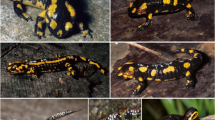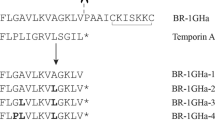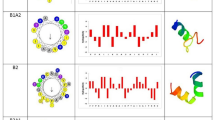Abstract
Given the current and future costs of antibiotic-resistant bacteria to human health and economic productivity, there is an urgent need to develop new antimicrobial compounds. Antimicrobial peptides are a promising alternative to conventional antibiotics and other antimicrobials. Amphibian skin is a rich source of bioactive compounds, but the antibacterial properties of salamander skin peptides have been neglected. Here, we examined the in vitro ability of skin peptides from 9 species of salamander representing 6 salamander families to inhibit the growth of ESKAPE pathogens, which are bacteria that have developed resistance to conventional antibiotics. We also examined whether the skin peptides caused lysis of human red blood cells. Skin peptides from Amphiuma tridactylum had the greatest antimicrobial properties, completely inhibiting the growth of all bacterial strains except for Enterococcus faecium. Likewise, skin peptides from Cryptobranchus alleganiensis completely inhibited the growth of several of the bacterial strains. In contrast, skin peptide mixtures from Ambystoma maculatum, Desmognathus fuscus, Eurycea bislineata, E. longicauda, Necturus beyeri, N. maculosus, and Siren intermedia did not completely inhibit bacterial growth even at the highest concentrations. Finally, none of the skin peptide mixtures caused lysis of human red blood cells. Together, we demonstrate that salamander skin produces peptides with potent antibacterial properties. It remains to elucidate the peptide sequences and their antibacterial mechanisms.




Similar content being viewed by others
Data Availability
Data are available on request from the authors.
Code Availability
Not applicable.
References
World Health Organization (2018) WHO report on surveillance of antibiotic consumption: 2016–2018 early implementation. World Health Organization, Licence CC BY-NC-SA 3.0 IGO, Geneva
Gajdacs M, Albericio F (2019) Antibiotic resistance: from the bench to patients. Antibiotics (Basel). https://doi.org/10.3390/antibiotics8030129
Ahmad M, Khan AU (2019) Global economic impact of antibiotic resistance: a review. J Global Antimicrob Resist 19:313–316. https://doi.org/10.1016/j.jgar.2019.05.024
Centers for Disease Control and Prevention (2019 Report) Antibiotic resistance threats in the United States. www.cdc.gov/drugresistance/pdf/threats-report/2019-ar-threats-report-508.pdf
O’Neill J (2016) Tackling drug-resistant infections globally: Final report and recommendations. The Review on Antimicrobial Resistance, Wellcome Trust
Bahar AA, Ren D (2013) Antimicrobial peptides. Pharmaceuticals (Basel) 6:1543–1575. https://doi.org/10.3390/ph6121543
Lazzaro BP, Zasloff M, Rolff J (2020) Antimicrobial peptides: application informed by evolution. Science. https://doi.org/10.1126/science.aau5480
Rima M, Rima M, Fajloun Z, Sabatier J-M, Bechinger B, Naas T (2021) Antimicrobial peptides: a potent alternative to antibiotics. Antibiotics (Basel, Switzerland) 10:1095. https://doi.org/10.3390/antibiotics10091095
Konig E, Bininda-Emonds OR, Shaw C (2015) The diversity and evolution of anuran skin peptides. Peptides 63:96–117. https://doi.org/10.1016/j.peptides.2014.11.003
Matsuzaki K (2009) Control of cell selectivity of antimicrobial peptides. Biochimica et Biophysica Acta (BBA)—Biomembranes 1788:1687–1692. https://doi.org/10.1016/j.bbamem.2008.09.013
Steckbeck JD, Deslouches B, Montelaro RC (2014) Antimicrobial peptides: New drugs for bad bugs? Expert Opin Biol Ther 14:11–14. https://doi.org/10.1517/14712598.2013.844227
Deslouches B, Steckbeck JD, Craigo JK, Doi Y, Burns JL, Montelaro RC (2015) Engineered cationic antimicrobial peptides to overcome multidrug resistance by ESKAPE pathogens. Antimicrob Agents Chemother 59:1329–1333. https://doi.org/10.1128/AAC.03937-14
Abdelbaqi S, Deslouches B, Steckbeck J, Montelaro R, Reed DS (2016) Novel engineered cationic antimicrobial peptides display broad-spectrum activity against Francisella tularensis, Yersinia pestis and Burkholderia pseudomallei. J Med Microbiol 65:188–194. https://doi.org/10.1099/jmm.0.000209
Gomes B, Augusto MT, Felicio MR, Hollmann A, Franco OL, Goncalves S et al (2018) Designing improved active peptides for therapeutic approaches against infectious diseases. Biotechnol Adv 36:415–429. https://doi.org/10.1016/j.biotechadv.2018.01.004
Dijksteel GS, Ulrich MMW, Middelkoop E, Boekema B (2021) Review: Lessons learned from clinical trials using antimicrobial peptides (AMPs). Front Microbiol 12:616979. https://doi.org/10.3389/fmicb.2021.616979
Tyagi A, Tuknait A, Anand P, Gupta S, Sharma M, Mathur D et al (2015) CancerPPD: a database of anticancer peptides and proteins. Nucleic Acids Res 43:D837–D843. https://doi.org/10.1093/nar/gku892
Tornesello AL, Borrelli A, Buonaguro L, Buonaguro FM, Tornesello ML (2020) Antimicrobial peptides as anticancer agents: functional properties and biological activities. Molecules 25:2850
Erspamer V (1994) Bioactive secretions of the amphibian integument. In: Heatwole H, Barthalmus GT (eds) Amphibian biology. The integument. Surrey Beatty, Chipping Norton, pp 178–350
Lillywhite HB (2006) Water relations of tetrapod integument. J Exp Biol 209:202–226. https://doi.org/10.1242/jeb.02007
Ladram A, Nicolas P (2016) Antimicrobial peptides from frog skin: biodiversity and therapeutic promises. Front Biosci (Landmark Ed) 21:1341–1371
Conlon JM, Mechkarska M (2014) Host-defense peptides with therapeutic potential from skin secretions of frogs from the family pipidae. Pharmaceuticals (Basel) 7:58–77. https://doi.org/10.3390/ph7010058
Pereira KE, Crother BI, Sever DM, Fontenot CL Jr, Pojman JA Sr, Wilburn DB et al (2018) Skin glands of an aquatic salamander vary in size and distribution and release antimicrobial secretions effective against chytrid fungal pathogens. J Exp Biol. https://doi.org/10.1242/jeb.183707
Fredericks LP, Dankert SR (2000) Antibacterial and hemolytic activity of the skin of the terrestrial salamander, Plethodon cinereus. J Exp Zool 287:340–345
Smith HK, Pasmans F, Dhaenens M, Deforce D, Bonte D, Verheyen K et al (2018) Skin mucosome activity as an indicator of Batrachochytrium salamandrivorans susceptibility in salamanders. PLoS ONE 13:e0199295. https://doi.org/10.1371/journal.pone.0199295
Karış M, Şener D, Yalçın HT, Nalbantsoy A, Göçmen B (2018) Major biological activities and protein profiles of skin secretions of Lissotriton vulgaris and Triturus ivanbureschi. Turkish J Biochem 43:605–612
Pei J, Jiang L (2017) Antimicrobial peptide from mucus of Andrias davidianus: Screening and purification by magnetic cell membrane separation technique. Int J Antimicrob Agents 50:41–46. https://doi.org/10.1016/j.ijantimicag.2017.02.013
Yang H, Lu B, Zhou D, Zhao L, Song W, Wang L (2017) Identification of the first cathelicidin gene from skin of Chinese giant salamanders Andrias davidianus with its potent antimicrobial activity. Dev Comp Immunol 77:141–149. https://doi.org/10.1016/j.dci.2017.08.002
Meng P, Yang S, Shen C, Jiang K, Rong M, Lai R (2013) The first salamander defensin antimicrobial peptide. PLoS ONE 8:e83044. https://doi.org/10.1371/journal.pone.0083044
Hime PM, Lemmon AR, Lemmon ECM, Prendini E, Brown JM, Thomson RC et al (2020) Phylogenomics reveals ancient gene tree discordance in the amphibian tree of life. Syst Biol 70:49–66. https://doi.org/10.1093/sysbio/syaa034
Madison JD, Berg EA, Abarca JG, Whitfield SM, Gorbatenko O, Pinto A et al (2017) Characterization of Batrachochytrium dendrobatidis inhibiting bacteria from amphibian populations in Costa Rica. Front Microbiol. https://doi.org/10.3389/fmicb.2017.00290
Pereira K, Woodley S (2021) Skin defenses of North American salamanders against a deadly salamander fungus. Anim Conserv 24:552–567
Pereira KE, Cava KA, Woodley SK (2021) An evaluation of immersive and handling methods for collecting salamander skin peptides. J Herpetol 55:318–324
Rollins-Smith LA, Reinert LK, Miera V, Conlon JM (2002) Antimicrobial peptide defenses of the Tarahumara frog, Rana tarahumarae. Biochem Biophys Res Commun 297:361–367
Zhou X, Willems RJL, Friedrich AW, Rossen JWA, Bathoorn E (2020) Enterococcus faecium: from microbiological insights to practical recommendations for infection control and diagnostics. Antimicrob Resist Infect Control 9:130. https://doi.org/10.1186/s13756-020-00770-1
Buda De Cesare G, Cristy SA, Garsin DA, Lorenz MC (2020) Antimicrobial peptides: a new frontier in antifungal therapy. MBio. https://doi.org/10.1128/mBio.02123-20
Woodhams DC, Rollins-Smith LA, Reinert LK, Lam BA, Harris RN, Briggs CJ et al (2020) Probiotics modulate a novel amphibian skin defense peptide that is antifungal and facilitates growth of antifungal bacteria. Microb Ecol 79:192–202
Conlon JM, Kolodziejek J, Mechkarska M, Coquet L, Leprince J, Jouenne T et al (2014) Host defense peptides from Lithobates forreri, Hylarana luctuosa, and Hylarana signata (Ranidae): phylogenetic relationships inferred from primary structures of ranatuerin-2 and brevinin-2 peptides. Comp Biochem Physiol Part D Genomics Proteomics 9:49–57. https://doi.org/10.1016/j.cbd.2014.01.002
Vasconcelos IAd, Souza JOd, de Castro JS, Santana CJCd, Magalhães ACM, Castro MdS et al (2021) Salamanders and caecilians, neglected from the chemical point of view. Toxin Rev. https://doi.org/10.1080/15569543.2021.1977326
von Byern J, Mebs D, Heiss E, Dicke U, Wetjen O, Bakkegard K et al (2017) Salamanders on the bench – A biocompatibility study of salamander skin secretions in cell cultures. Toxicon 135:24–32. https://doi.org/10.1016/j.toxicon.2017.05.021
Deslouches B, Montelaro RC, Urish KL, Di YP (2020) Engineered cationic antimicrobial peptides (eCAPs) to combat multidrug-resistant bacteria. Pharmaceutics 12:501
Ahmed TAE, Hammami R (2019) Recent insights into structure–function relationships of antimicrobial peptides. J Food Biochem 43:e12546. https://doi.org/10.1111/jfbc.12546
Assoni L, Milani B, Carvalho MR, Nepomuceno LN, Waz NT, Guerra MES, et al. (2020) Resistance mechanisms to antimicrobial peptides in Gram-positive bacteria. Frontiers in Microbiology 11. https://doi.org/10.3389/fmicb.2020.593215
Li M, Cha DJ, Lai Y, Villaruz AE, Sturdevant DE, Otto M (2007) The antimicrobial peptide-sensing system aps of Staphylococcus aureus. Molecular Microbiology 66:1136–1147. https://doi.org/10.1111/j.1365-2958.2007.05986.x
Lázár V, Martins A, Spohn R, Daruka L, Grézal G, Fekete G et al (2018) Antibiotic-resistant bacteria show widespread collateral sensitivity to antimicrobial peptides. Nat Microbiol 3:718–731. https://doi.org/10.1038/s41564-018-0164-0
Woodley SK, Staub NL (2021) Pheromonal communication in urodelan amphibians. Cell Tissue Res 383:327–345. https://doi.org/10.1007/s00441-020-03408-1
Largen W, Woodley SK (2008) Cutaneous tail glands, noxious skin secretions, and scent marking in a terrestrial salamander (Plethodon shermani). Herpetologica 64:270–280
Woodley SK (2010) Pheromonal communication in amphibians. J Comp Physiol A 196:713–727
Brodie EDJ (1983) Antipredator adaptations of salamanders: Evolution and convergence among terrestrial species. In: Margaris NS, Arianoutsou-Faraggitaki M, Reiter RJ (eds) Adaptations to Terrestrial Environments. Plenum Press, New York, pp 109–133
Woodley SK (2014) Chemical signaling in amphibians. In: Mucignat-Caretta C (ed) Neurobiology of Chemical Communication. Frontiers in Neuroscience Series, CRC Press/Taylor and Francis, Boca Raton, pp 251–280
Roope LSJ, Smith RD, Pouwels KB, Buchanan J, Abel L, Eibich P et al (2019) The challenge of antimicrobial resistance: what economics can contribute. Science 364:eaau4679. https://doi.org/10.1126/science.aau4679
Acknowledgements
We thank P. Clemenza, A. Magyan, L. Rajakumar, and T. Ricketts for help in method development. We thank K. Emerson, A. Millikin, L. Muse, B. Porter, and K. Regester for help collecting amphibian skin secretions. We thank J. Klousnitzer for completing the hemolysis assays. We thank R. Yurko and K. Islam for help with the RP-HPLC.
Funding
This research was supported through funding by the Samuel and Emma Winters Foundation, the Charles Henry Leach II Fund, the Pittsburgh Foundation, and Duquesne University (Community-Engaged Seed Grant Award) to SKW. It was also funded by the National Institutes of Health RO1 GM125917 to BD.
Author information
Authors and Affiliations
Contributions
SKW and KEP conceived of the experiments; SKW, KEP, and BD designed the experiments; JTD and KEP executed the experiments, analyzed the results, and made figures; SKW and KEP wrote the first draft of the manuscript; all authors contributed to the writing of the manuscript.
Corresponding author
Ethics declarations
Conflict of interest
The authors declare that they have no conflict of interest.
Ethical Approval
Animal collection and use were permitted by the Pennsylvania Fish and Boat Commission (Permit No. 2020-01-0028), Louisiana Department of Wildlife and Fisheries (Permit No. WPD-20-062) and approved by Duquesne University’s Institutional Animal Care and Use Committee (IACUC Nos. 1708-07 and 1806-06). The human samples from which the red blood cells were isolated were from anonymous donors and commercially provided by the Central Blood Bank (Pittsburgh, PA, USA). Therefore, this did not require approval from the Institutional Review Board or any ethics committee.
Additional information
Publisher's Note
Springer Nature remains neutral with regard to jurisdictional claims in published maps and institutional affiliations.
Supplementary Information
Below is the link to the electronic supplementary material.
Rights and permissions
Springer Nature or its licensor (e.g. a society or other partner) holds exclusive rights to this article under a publishing agreement with the author(s) or other rightsholder(s); author self-archiving of the accepted manuscript version of this article is solely governed by the terms of such publishing agreement and applicable law.
About this article
Cite this article
Pereira, K.E., Deslouches, J.T., Deslouches, B. et al. In Vitro Investigation of the Antibacterial Activity of Salamander Skin Peptides. Curr Microbiol 80, 214 (2023). https://doi.org/10.1007/s00284-023-03320-1
Received:
Accepted:
Published:
DOI: https://doi.org/10.1007/s00284-023-03320-1




